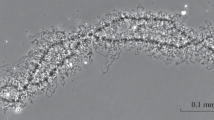Summary
1. The bulb of theX-chromosome ofD. melanogaster and branched chromosomes in general are interpreted to be symmetrical duplications formed by a continuous unbranched chromonema.
2. An explanation of the formation of symmetrical duplications is advanced, and evidence for a single event producing more than one break is presented.
3. The bulb antedates the evolutionary split ofD. melanogaster andD. simulans, since it is present in both species. The homology of the two arms of the duplication and therefore of the duplicated genes themselves, could be preserved by the possibility of crossing-over which exists in this type of rearrangement.
4. Some of the observed structural features are referred to certain internal forces in the chromosomes, such as the attraction between homologous chromomeres and the tension within the chromonemas.
5. Sexual dimorphism in regard to theX-chromosome in general and to the bulb in particular has been described. This is interpreted as an expression of a difference in the force of synaptic attraction in the cells of male and female.
Similar content being viewed by others
References
Bridges, C. B. (1935). “Salivary chromosome maps.”J. Hered. 26, 60–4.
Friesen, H. (1932). “Vergleichende Untersuchung der Häufigkeit somatischer Chromosomenbrüche beiDrosophila—Weibchen und Männchen.”Biol. J. 1, 47–51.
Heitz, E. (1934). “Überα- undβ-Heterochromatin sowie Konstanz und Bau der Chromomeren beiDrosophila.”Biol. Z. 54, 588–609.
Kossikoff, R. V. andMuller, H. J. (1935). “Invalidation of the genetic evidence for branched chromonemas in the case of Pale translocation.”J. Hered. (in press).
Muller, H. J. (1918). “Genetic variability, twin hybrids and constant hybrids, in a case of balanced lethal factors.”Genetics,3, 422–99.
—— (1935a). “The origination of chromatin deficiencies as minute deletions subject to insertion elsewhere.”Genetica,17, 237–52.
Muller, H. J. (1935b). “A viable two-gene deficiency phenotypically resembling the corresponding hypomorphic mutations.”J. Hered.
Panshin, L. (1935). “New evidence for the position effect hypothesis.”C.R. Acad. Sci. U.S.S.R. (in press).
Patterson, J. T. (1933). “The mechanism of mosaic formation inDrosophila.”Genetics,18, 32–52.
Prokofyeva, A. A. (1935). “The structure of the chromocentre.”C.R. Acad. Sci. U.S.S.R.
Author information
Authors and Affiliations
Rights and permissions
About this article
Cite this article
Offermann, C.A. Branched chromosomes as symmetrical duplications. Journ. of Genetics 32, 103–116 (1936). https://doi.org/10.1007/BF02982505
Issue Date:
DOI: https://doi.org/10.1007/BF02982505




